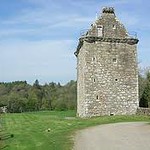The Armstrong Clan Tour
Tour that explores the Borders heritage of this famous Scottish Borders family that date back to the 11th century. The itinerary starts in Edinburgh and then over the course of 3 days explores the Borders region.
Day 1 Melrose & Jedburgh
Visit Melrose and especially the historic Melrose Abbey where the heart of Robert the Bruce is interred. Also visit Dryburgh Abbey and revel in the turbulent history - it has seen four wars and three burnings! Afterwards continue on to Jedburgh and another historic abbey.
Accommodation: Hotels in Melrose | Hotels in Jedburgh | Hotels in Scotland
Day 2 - Hawick, Teviothead & Langholm
Hawick is the largest borders town and once a prosperous wool town, although times have changed and the prosperity has largely left. Visit the Hawick Museum for some insight. (see Hotels in Hawick )
South of Hawick is Teviothead and the home of the Armstrong Clan where Johnnie Armstrong in the 1520s established a protection racket that formed the basis of Armstrong power and wealth. The Scottish King was unhappy and tricked said Johnnie to meet him in Hawick in 1530 and summarily executed him.
In Langholm is Peel Tower which was once the home of the Armstrong Clan. The moon played an important role in Armstrong raiding plans; the phrase "There will be moonlight again" being a signal for the next raid. This is rather coincidental when we remember that the astronaut Neil Armstrong was the first man to walk on the moon in 1969.
Day 3
Drive south until you reach Canonbie which lies on the Scottish border at the end of Liddesdale where the River Liddel joins with the River Esk. The Armstrongs were given the lands of Liddesdale in recognition for their services to an early Scottish King. This was the Clan Chief"s seat and the site of their stronghold. It was said that they could muster 3000 horsemen and were in virtual control of all the border lands. Canonbie is the site of Gilnockie Tower and Clan Armstrong Trust Museum which houses Armstrong genealogical records, artifacts and memorabilia.
Gilnockie Tower dates from the 16th century and provides fantastic views across the Armstrong heartland. A beacon grate perched on the roof was used as part of a signalling system.
Also in the area is Rowanburn, where a carving commemorates Lang Sandy, Alexander Armstrong, a border reiver executed in 1606. The cross-border conflicts were officially ended with the union of the Scottish and English crowns in 1603, but old habits die hard and in 1610 the last Armstrong Clan chief to be hanged for reiving met his fate.
Take the road northeast along the Liddesdale valley. One mile to the south of Newcastleton you will find Milnholm Cross which is a memorial to the respected and much loved Laird Alexander Armstrong who was murdered by William de Soulis in 1318. The de Soulis family seat was at Hermitage Castle a few miles north of Newcastleton. Find out about the grissly deed and the legend of the nasty end which de Soulis is said to have suffered as a consequence of this murder.
Half a mile along the side road from the Milnholm Cross is Ettleton Cemetery, Alexander"s final resting place, together with many other Armstrongs. From this cemetery the remains of Mangerton Tower, the family"s first power base in Scotland, can be seen.



